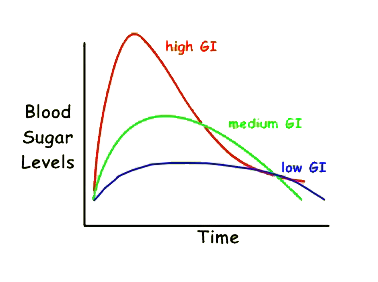The Glycaemic Index
The rate at which carbohydrate impacts on your blood glucose level depends chiefly on the amount of carbohydrate you have consumed (the carbohydrate load) and, to a lesser extent, the type of carbohydrate you have consumed (the glycaemic index).
The glycaemic index (GI) is a scale from 1 to 100 that is used to measure how quickly foods that contain carbohydrate raise blood glucose levels. Foods that contain carbohydrate are given a GI value; foods that have little or no carbohydrate, e.g. cheese, meat, fish and eggs, will have no GI value.
Carbohydrate foods that break down quickly during digestion raise the blood glucose more quickly, and have a higher GI value (greater than 70). Foods that break down more slowly during digestion raise the blood glucose more slowly and so have a lower GI value (less than 55).
Mixing foods with different GI values creates a new GI for the meal. Swapping high-GI foods for medium-GI or low-GI options may help you to control your diabetes better, improve your cholesterol level, and achieve and maintain a healthy weight.
When you are planning your meals, you should consider how to incorporate the GI into your food choices. The following are useful pointers:
- Mixing high-GI foods with lower-GI alternatives will help to lower the overall GI of the meal. For example: High-GI food (baked potato) + low-GI food (baked beans) = medium-GI meal
- Low-GI foods are not always healthy. For example, ice cream, nuts and chocolate all have a low to medium GI but are high in fat and calories. Such items should be eaten in small quantities.
- High-GI foods, e.g. watermelon, can be a good source of nutrients, so they do not need to be avoided altogether just because they have a rapid and marked effect on your blood glucose levels.
- Focus on the overall GI content of your meal to keep your blood glucose levels within a target range.
- For a healthy, balanced approach to eating, include low-fat and low-sugar foods with a lower GI as a basis for meal and snacks
The diagram below demonstrates how low-, medium- and high-GI foods can affect blood glucose over time.

Table 1 illustrates the GI values of some common foods.
Table 1: Low, medium and high GI values
|
|
Low GI Less than 55 |
Medium GI 55–70 |
High GI Greater than 70 |
|
Breakfast cereals |
All Bran Sultana Bran Muesli Porridge oats |
Instant porridge Weetabix Shredded Wheat Special K |
Coco Pops Rice Krispies Cornflakes Cheerios |
|
Bread, biscuits, cakes, confectionery |
Rye bread Pumpernickel bread |
Granary or multigrain bread Pitta bread Wholemeal bread Crumpet Digestive biscuit Rich Tea Chocolate |
Baguette White bread Bagel |
|
Potatoes, rice, pasta |
Sweet potatoes Noodles Pasta |
New potatoes Boiled potatoes Couscous Brown rice Basmati rice Crisps |
Instant potatoes Baked potatoes Instant rice Chips |
|
Fruit and vegetables |
Apples Grapefruit Grapes Kiwis Oranges Peaches Pears Carrots Peas |
Apricots Mangoes Pineapples Raisins Sultanas Melons |
Watermelon Turnip Parsnips |
|
Beans and pulses |
Baked beans Butter beans Black beans Kidney beans Chick peas Lentils Nuts |
|
Broad beans |
|
Milk and dairy |
Milk Custard Yoghurt |
Ice cream |
|
The key is to use the GI in the context of balanced eating. A healthy way to use the GI principles is to incorporate a range of lower GI carbohydrates that are also low in fat and calories into your meals.
Useful resources
The following is a source of more useful information about the GI and how it can benefit your diet:
http://www.the-gi-diet.org/glycemicindexchart/

